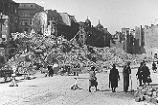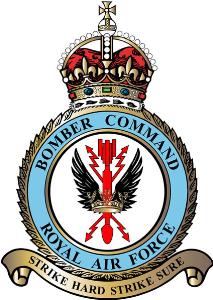
RAF Bomber Command controlled the Royal Air Force's bomber forces from 1936 to 1968. Along with the United States Army Air Forces, it played the central role in the strategic bombing of Germany in World War II. From 1942 onward, the British bombing campaign against Germany became less restrictive and increasingly targeted industrial sites and the civilian manpower base essential for German war production. In total 364,514 operational sorties were flown, 1,030,500 tons of bombs were dropped and 8,325 aircraft lost in action. Bomber Command crews also suffered a high casualty rate: 55,573 were killed out of a total of 125,000 aircrew, a 44.4% death rate. A further 8,403 men were wounded in action, and 9,838 became prisoners of war.

The Kassel World War II bombings were a set of Allied strategic bombing attacks which took place from February 1942 to March 1945. In a single deadliest raid on 22–23 October 1943, 150,000 inhabitants were bombed-out, at least 6,000 people died, the vast majority of the city center was destroyed, and the fire of the most severe air raid burned for seven days. The US First Army captured Kassel on 3 April 1945, where only 50,000 inhabitants remained, versus 236,000 in 1939.

The city of Würzburg was attacked as part of the strategic bombing campaign in World War II by the Allies against Nazi Germany. Although lacking major armaments industries and hosting around 40 hospitals at the time, Würzburg was targeted as a traffic hub and as part of the attempt by Bomber Command to break the spirit of the German people. The major raid occurred on March 16, 1945, when Royal Air Force bombers dropped incendiary bombs that set fire to much of the city, killing an estimated 5,000 people and almost completely obliterating the historic town. Almost 90% of the buildings were destroyed by a raid that lasted less than 20 minutes.

The Bucharest World War II bombings were primarily Allied bombings of railroad targets and those of the Oil Campaign of World War II, but included a bombing by Nazi Germany after the 1944 coup d'état. Bucharest stored and distributed much of Ploiești's refined oil products.

Darmstadt was bombed a number of times during World War II. The most devastating air raid on Darmstadt occurred on the night of 11/12 September 1944 when No. 5 Group of the Royal Air Force (RAF) bombed the city. 66,000 of the 110,000 inhabitants of Darmstadt at the time became homeless. Darmstadt lost between 12,500 and 13,500 inhabitants during World War II. The calligraphic memorial Darmstädter Brandnamen lists about 4,000 names. Darmstadt had several major industrial targets including Merck and Rohm and Haas chemical works as well as military communications networks.

The bombing of Königsberg was a series of attacks made on the city of Königsberg in East Prussia during World War II. The Soviet Air Force had made several raids on the city since 1941. Extensive attacks carried out by RAF Bomber Command destroyed most of the city's historic quarters in the summer of 1944. Königsberg was also heavily bombed during the Battle of Königsberg, in the final weeks of the war.

Duisburg was bombed a number of times by the Allies during World War II. The most devastating air raids on Duisburg occurred during October 1944 when the city was bombed by the Royal Air Force (RAF).

During World War II, the industrial town of Essen, was a target of Allied strategic bombing. The Krupp steelworks was an important industrial target, Essen was a "primary target" designated for area bombing by the February 1942 British Area bombing directive.
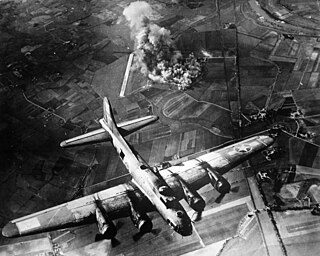
The Combined Bomber Offensive (CBO) was an Allied offensive of strategic bombing during World War II in Europe. The primary portion of the CBO was directed against Luftwaffe targets which was the highest priority from June 1943 to 1 April 1944. The subsequent highest priority campaigns were against V-weapon installations and petroleum, oil, and lubrication (POL) plants. Additional CBO targets included railyards and other transportation targets, particularly prior to the invasion of Normandy and, along with army equipment, in the final stages of the war in Europe.

Tuz Khurmatu is the central city of Tooz District in Saladin Governorate, Iraq, located 55 miles (89 km) south of Kirkuk. Its inhabitants are predominantly Shia Turkmen, with a minority of Arabs and Kurds.

During World War II, the Estonian capital Tallinn suffered from many instances of aerial bombing by the Soviet air force and the German Luftwaffe. The first bombings by Luftwaffe occurred during the Summer War of 1941 as part of Operation Barbarossa. A number of Soviet bombing missions to then German-occupied Tallinn followed in 1942–1944.

The Bombing of Bremen in World War II by the British Royal Air Force (RAF) and US Eighth Air Force involved both indiscriminate "area bombing" and, as capacity improved, more targeted raids upon the city's military-industrial facilities. These included the shipyards of Vulkan, AG Weser and Atlas Werke, the Valentin submarine pens, oil refineries and the aircraft works of Focke-Wulf.
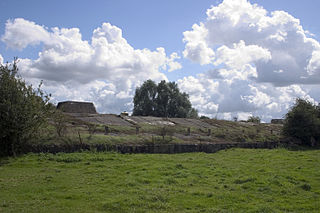
The Siracourt V-1 bunker is a Second World War bunker built in 1943–44 by the forces of Nazi Germany at Siracourt, a commune in the Pas-de-Calais department in the Nord-Pas-de-Calais region of France. Codenamed Wasserwerk St. Pol, it was intended for use as a bomb-proof storage facility and launch site for V-1 flying bombs. However, it never went into operation due to intensive Allied bombing that made it the most heavily attacked of all the German V-weapon sites, and also of all military targets in Europe during World War II.
Allied bombing of the oil campaign targets of World War II included attacks on Nazi Germany oil refineries, synthetic oil plants, storage depots, and other chemical works. Natural oil was available in Northwestern Germany at Nienhagen, Rietberg (20%—300,000), and Heide (300,000) and refineries were mainly at Hamburg and Hannover. Refineries in France, Holland, and Italy (54)—mainly coastal plants for ocean-shipped crude—were within Allied bombing range and generally unused by Germany. Even before the war, Germany was dependent on foreign sources for an adequate supply of oil. The annexations of Austria and the Sudetenland ; the "campaigns in Norway, Holland, Belgium, and France…and imports from the Soviet Union provided significant wartime POL imports to Nazi Germany. Firms that operated oil facilities included Deutsche Erdöl-Aktiengesellschaft, Brabag, Fanto, and I.G. Farbenindustrie.
The oil campaign chronology of World War II lists bombing missions and related events regarding the petroleum/oil/lubrication (POL) facilities that supplied Nazi Germany or those Germany tried to capture in Operation Edelweiss.
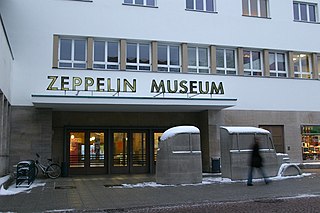
The German city of Friedrichshafen was bombed during World War II as part of the Allied strategic bombing campaign against German war materiel industry, particularly in the targeting of German fighter aircraft production and long range missile development.
The bombing of Ludwigshafen and Oppau in World War II attacked several strategic targets in the area, including targets of the Oil Campaign of World War II. Ludwigshafen oil plants were managed by Dr. Wurster of the Ludwigshafen Military Government, and their chief function was to improve "gasoline quality by dehydrogenation" using the DHD process. Ludwigshafen also refined "30-50 tons/day of crude oil...brought in from Brücksel, near Karlsruhe...to products including lube oils." About 2.5 miles away from Ludwigshafen, an Oppau plant produced fertilizer and up to "800 T/day nitrogen as ammonia and a considerable part of this was exported as liquid ammonia to Hochst, Wolfen and Bittefeld." A separate Oppau plant produced up to 60 T/day of urea. Dr. Gogel was head of the "high pressure department" at Oppau. After visiting the Ludwigshafen and Oppau factories from March 25–31 and 27–30 May, in August 1946, a post-war team published the Report On Investigations by Fuels and Lubricants Teams At The I.G. Farbenindustrie, A. G., Works, Ludwigshafen and Oppau.

Dauntless Dotty is the nickname of a Boeing B-29-40-BW Superfortress during the Second World War that led the first B-29 raid on Tokyo on 24 November 1944, the first bombing attack of the Japanese capital since the Doolittle Raid on 18 April 1942.
